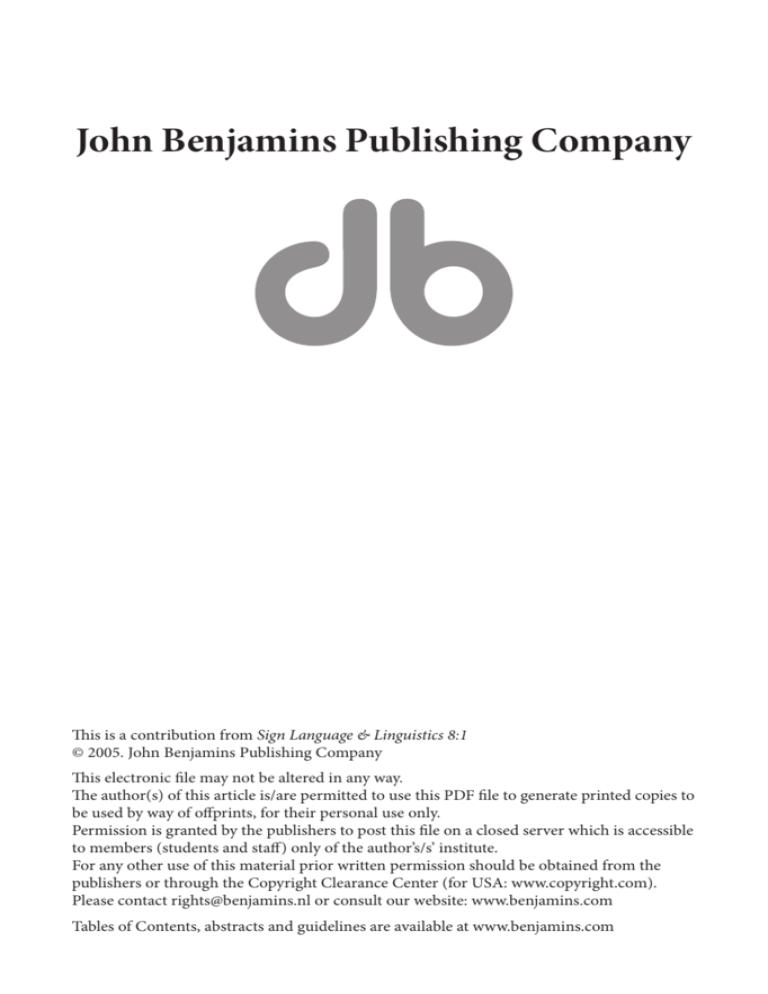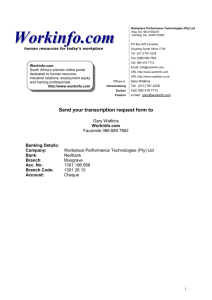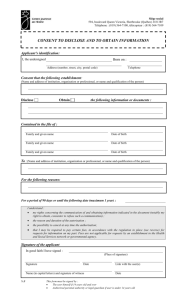
John Benjamins Publishing Company
This is a contribution from Sign Language & Linguistics 8:1
© 2005. John Benjamins Publishing Company
This electronic file may not be altered in any way.
The author(s) of this article is/are permitted to use this PDF file to generate printed copies to
be used by way of offprints, for their personal use only.
Permission is granted by the publishers to post this file on a closed server which is accessible
to members (students and staff) only of the author’s/s’ institute.
For any other use of this material prior written permission should be obtained from the
publishers or through the Copyright Clearance Center (for USA: www.copyright.com).
Please contact rights@benjamins.nl or consult our website: www.benjamins.com
Tables of Contents, abstracts and guidelines are available at www.benjamins.com
Transcription of child sign language
A focus on narrative*
Gary Morgan
City University, London
This paper describes some general difficulties in analysing child sign language data with an emphasis on the process of transcription. The particular
issue of capturing how signers encode simultaneity in narrative is discussed.
Keywords: sign language acquisition, transcription, narratives
1. Introduction
The study of child sign language has emerged from the growing interest in crosslinguistic comparisons of language development, stimulated greatly by the early
work on American Sign Language (ASL) (e.g. Newport & Meier 1986). However the modality in which sign language is produced has made it difficult to
compare sign languages with each other because of a lack of an agreed normative transcription system to represent child forms of sign languages, articulated
through movements of the hands, arms, body and face. Progress has also been
hampered by the difficulty in storing transcribed sign data in a format which
permits computer-based searches. Despite these early challenges, current research findings on child sign language acquisition are greatly contributing to
the study of language acquisition (see Morgan & Woll, 2002, and this volume).
* Parts of this research were presented at the ‘Intersign’ meeting on Child Sign Language
(September 1999) at City University, London and the Linguistics Association of Great Britain meeting (April 2002). An earlier version of this paper appeared as Morgan (2003). The
transcription system presented has been the result of discussion with several colleagues. I
would like to thank in particular Bencie Woll, Judy Kegl, Elena Pizzuto, Beppie van den
Bogaerde, Maria Sidonio Armas Pais and Jim Kyle. I would also like to thank Anne Baker
for comments on this paper.
Sign Language & Linguistics 8:1/2 (2005), 117–128.
issn 1387–9316 / e-issn 1569–996x © John Benjamins Publishing Company
118 Gary Morgan
This paper outlines some issues in studying child sign language at the level of
transcription.
A transcription system can only record selected aspects of the language
under study. This is equally true for speech and for sign (Pizzuto & Pietrandrea,
2001). Transcription allows us to capture in a static form one piece of the linguistic puzzle for later coding and analysis. The choice of transcription system
used will depend on the specific research question asked. The transcription
system adopted will mould the sign language data into a shape that is more
accessible; in other words the transcription is not the same as the raw data (see
papers in the special issue of Sign Language and Linguistics — Bergman, BoyesBraem, Hanke & Pizzuto 2001).
In much child and adult sign language research there are striking differences between the written transcriptions provided by different authors. Depending
on the level of analysis focused on, transcription may include a representation
of the sign’s form, information on accompanying nonmanual features, and use
of sign space. Apart from some standard notation devices such as linked spoken language translations (glosses) and markers of sign modifications (e.g. ‘+’
to mark repetition of a whole sign, or sub- and super-scripts to show agreement
relations (diacritics)), very little direct comparison between sign languages is
possible based on the written transcription alone. Hoiting and Slobin make
these two important points:
‘…a mixed system of glosses and diacritics is inaccessible to computer programs of the sort used in child language research. More seriously, the glosses
represent the nearest translation equivalent in the spoken language of the particular community, making it impossible to carry out serious linguistic analysis of the sign language itself.’ (Hoiting & Slobin, 2002, p60)
This comment sets the goals for sign language transcription, and as a consequence for child sign language research. A good transcription system should
allow researchers to do two main things:
1. Exploit computer technologies for searching and collating coded utterances
2. Share transcribed examples with other scholars working on similar questions both in signed and spoken language.
As an example of how a computer-archived normative transcription system can
stimulate research, consider the advances that have been made since the advent
of CHILDES (MacWhinney 2000; http://childes.psy.cmu.edu/). Hoiting, Slobin and colleagues, in response to the observed shortcomings of current sign
© 2005. John Benjamins Publishing Company
All rights reserved
Transcription of child sign language 119
language transcription, have proposed a CHILDES-compatible transcription
system to represent sign language morphology (Slobin et al. 2001).
The structure of the paper is the following: first some special issues relating to child sign language research are reviewed including how child ‘errors’
are transcribed. I then describe recent work on sign language narrative development and how reference and space are coded and transcribed for in this
genre. Limitations of the ‘dynamic transcription system’ are discussed in the
final section.
2. The challenge of transcribing children’s signing
When an adult sign is transcribed, at least five parameters (handshape, location, movement, palm orientation and facial action) can be recorded, using one
of several transcription systems (see Bergman et al. 2001; Takkinen this volume). One of the most popular ways of representing a sign on paper is Stokoe
notation (Stokoe 1960) or later modifications (e.g. Brennan et al. 1984). This
system works well for presenting the general structure of single lexical signs.
Stokoe’s system is a notation system rather than a phonological transcription.
For example, one of the BSL signs for DOG in Stokoe transcription would be
represented as (Fig. 1).
Figure 1. BSL sign dog in a variant of Stokoe notation
This represents the sign’s citation form. Underspecification begins with the
symbol for location (Ø), which indicates the sign is produced in neutral sign
space, that is, in front of the signer’s body. Problems arise when it is necessary
to transcribe the same sign in connected discourse in the presence of co-articulation. The citation forms of signs are modified in the context of normal communication and the researcher may wish to describe this phonetic modification
. This paper focuses on transcription. For a more general discussion of the collection and
analysis of child sign language data, see Baker, van den Bogaerde & Woll (this volume).
© 2005. John Benjamins Publishing Company
All rights reserved
120 Gary Morgan
(see Takkinen, this volume). Furthermore, in acquisition studies, a researcher
may wish to note how the citation form of a sign might be produced in a radically different manner as a result of immature development.
Children modify sign forms as they acquire them. The suggested constraints responsible for some of these modifications have been a strong source
of evidence for the analysis of signs at the phonological level (e.g. Bonvillian
& Siedlecki 1996; Van der Hulst 1996). Young children systematically modify
all parameters: handshape, movement, location, hand orientation and facial
actions accompanying signs, so that these differ in form from those produced
by adults in the input the children receive. These differences in production are
resolved as children grow older.
Some of the features of children’s signing that make phonological and
morphological transcription difficult relate to the ‘phonetic’ properties of sign
languages: the production of signs through movements of hands, arms and
faces. Children have poorer motor control than adults and as a result, a sign or
sequence of signs may be produced with extensive changes. For example:
1. Two handed signs may be produced with one hand
2. One handed signs may be produced with two hands
3. Parts of signs may be omitted as they are co-articulated with the next sign
in a sequence
4. Manual and nonmanual features may be interspersed with general facial,
head and body movements
Young children before the age of 3 years, as well as having immature phonetic
and phonological development, lack pragmatic knowledge. For example, while
signing they may move around, pick objects up, look away from the addressee,
or produce signs in locations where they cannot be seen by the conversational
partner, for example in the corner of a doll’s house ( Baker & van den Bogaerde
2005).
If the researcher is concerned with sign phonology, it will be important
to record all phonetic modifications from the adult form in order to explore
developmental patterns such as consonant harmony, reduction, assimilation
or substitution (Morgan, in press). If the research is concerned with how the
child productively uses sign and meaning combinations, then such phonetic
detail is superfluous, and English glosses of the child’s intended meaning may
suffice e.g. dog meat eat ‘Dogs eat meat’. The gloss ‘dog’ does not encode that
e.g. across five tokens the sign was produced differently each time, nor whether
there was any developmental progression towards the adult target phonological
© 2005. John Benjamins Publishing Company
All rights reserved
Transcription of child sign language 121
form across these five instances, but this would not be required for a study of
semantic development.
Elaborate transcription methods, such as those referred to above, are in
use, but these may be specific to a single research group, not suitable for storage
in a database or not amenable to computer search algorithms. As an alternative,
in presenting the results of research, many researchers provide line drawings,
photos, and computer models of child sign forms or accompany glosses with
stylised versions of the signs movement (see papers in Bergman et al. 2001).
An example of the acquisition of verb agreement morphology in sign
languages will illustrate some of the difficulties. Verb agreement morphology
involves the movement of a sign between indexed locations in sign space to
indicate the subject and object of a verb phrase. Transcription requires the capture of this movement in a static visual form. The exact area of sign space in
which the sign moves cannot be captured unless exact map co-ordinates are
used; instead most researchers mark the movement with a subscript which indicates only that there was movement between two locations., for example, a
glossed verb with diacritics–1give2 ‘I give you’. The diacritics refer to person
agreement — the verb give moved from the first person location (the signer’s
own chest) towards the second person location (the addressee). If our research
question concerns which category of person agreement morphology emerges
first in children’s signing (1st person to 2nd person or another combination),
this transcription will serve our purposes. This gloss is, however, highly abstracted from the data: it does not tell us what the sign looked like, what the
movement looked like and if there were any deviations made by the child from
the target adult model. We do not know with this gloss what morphemic structure the sign has; as Hoiting & Slobin (2002) pointed out, we are influenced
by the meaning of the English gloss. The gloss does not tell us what part of the
sign represents the inflection used for person agreement. This example illustrates again the need for the type of transcription used to be determined by the
research question.
The type of transcription must also be matched to the type of data collected. Data can be naturalistic or elicited; spontaneous conversation or narrative.
Different data types present different problems for transcription, since different structures may predominate in different types of data. In the following section narratives and the problems they pose for transcription will be considered
in more detail.
. It should, however, be noted that there are issues about informant confidentiality when
images of children are used (see Baker, Van den Bogaerde & Woll (this volume).
© 2005. John Benjamins Publishing Company
All rights reserved
122 Gary Morgan
3. Transcribing BSL narrative devices
When transcribing signed narratives, the transcription system has to capture
glosses of signs at the level of sign meaning, information about sign forms,
nonmanual features and also a record of the locations to which different spatial
forms are directed through referential devices (e.g. Friedman 1975; Johnston
1991; Engberg-Pedersen 1994; Liddell 1995).
Languages have different linguistic resources for selecting and handling how
people and objects are related in sentences and discourse. References to people
in English, for example can be through noun phrases — ‘the boy’; pronouns
— ‘he’; or through a verb phrase that relies on a previous overt mention of the
referent — ‘the boy saw the beehive, then climbed up the tree’. In sign languages
reference is encoded through grammatical markers that function via agreement
with locations in space. BSL, like many other sign languages, uses space to tie
pronouns and noun phrases to their dependent referents and verb arguments,
thereby indicating who did what to whom (Sutton-Spence & Woll. 1999).
In narrative the sign space is used and reused for referent locations which
may continually change during the telling of a story. The ability of the transcription to capture the transitions between different uses of sign space is important when looking at how reference to people and locations are articulated
in narrative. One such device is the establishment of overlapping representational spaces to indicate simultaneity. Morgan (1999) describes adult use of
sign space in BSL for retelling ‘Frog Story’ narratives (Mayer 1987). In one
particular episode of the Frog Story, simultaneous events occur in the same
picture (see pictures 1 and 2 in Figure 2). The boy is searching for his frog in a
tree and the dog has upset a beehive in picture 1 and in picture 2 the boy falls
out of the tree frightened by the owl that appears while the dog is being chased
by the bees. Adult signers normally narrate these events by setting up several
interlinked sign spaces in quick succession.
The encoding of simultaneity in discourse, that is, when two events happen
at the same time, reveals the complexity of using sign space (see Morgan 2002).
A method for recording this use of sign space, which I call ‘Dynamic Space
Transcription’, has been developed recently (see Morgan 1999, 2002 but also
Liddell 1995). Signed discourse viewed in this way consists of a set of overlapping representational spaces. The system is schematised in Figure3.
© 2005. John Benjamins Publishing Company
All rights reserved
Transcription of child sign language 123
Picture 1
Picture 2
Figure 2. Illustrations from Frog, where are you?
Figure 3. Interactions and use of space in narrative
The box in Figure 3 represents the narrative as a whole. Within the narrative,
the the plot line is represented by the direction of the arrow. In characterising
narrative discourse I have described two different uses of space: for locating
referents in a kind of fixed template (Fixed Referential Space (FRS)) and ‘role
© 2005. John Benjamins Publishing Company
All rights reserved
124 Gary Morgan
shift’ for describing referents from a movable first person perspective (Shifted
Referential Space (SRS)) (see Morgan 1999, 2002 for a fuller description of the
SRS and FRS). The FRS and SRS can directly map how the signer used these
sign space, with individual reference forms placed within these two spaces.
Included alongside the time line are any discourse markers provided by the
narrator to assist in interpretation of the use of sign space (glossed ><). To
illustrate how this approach works, consider the sign utterance in (1) (see appendix for explanation of symbols used here and in later examples).
(1) dog jump-up++ try catch-hive fall boy no-see £ look-rightshocked
‘…the dog is jumping up and down again and again, trying to get to the
hive hanging from the tree. When it falls onto the ground, the boy, as he
didn’t see what happened, turns around shocked…’
This part of the Frog Story involves the signer establishing the areas of sign
space that will be used to move between the boy and the dog. A fuller gloss
captures some of the use of nonmanual markers, especially eyegaze and the
direction of verb movements in the SRS.
(2)
‑‑ ^^ ><
_____ ___________ _________________
// £ dog jump-up++ try catch-hive fall
<<
_____________ ___________________
boy no-see £ look-right-shocked
The interaction between sign spaces is not evident in this form of transcription.
If we take the sign space out of the transcription and represent it as a dynamic
space transcription, interpretation becomes clearer. This is shown in Figure 4.
The movement to the first use of role shift in the SRS occurs when the
dog’s actions are being described and involves moving the dog to the right of
sign space, resulting in an exchange of the two SRS’s. This involves a reversal in perspective as the boy’s perspective exchanges with that of the dog. The
adult signer uses noun phrases to make sure the identity of the SRS’s are clear.
Once this has been established, the signer uses no further overt identification
of BOY. Additional information for interpreting these switches in perspective
and sign space is supplied by eyegaze towards the addressee. Eyegaze functions
in these kinds of texts as a signal to ‘pay attention’ as well as being a means of
© 2005. John Benjamins Publishing Company
All rights reserved
Transcription of child sign language 125
DOG
>< HIVE FALL
Reversal in perspective
BOY
(DOG)
>< SHOCKED
LOOK RIGHT
(BOY)
Figure 4. An illustration of the dynamic space
checking for understanding. In young signers (before 5–6 years) these looks to
the addressee are absent for the most part. Children both in sign and spoken
languages may begin to tell stories assuming that their addressees have full
access to the identities of referents (Hickman, Kail & Roland, 1996). Through
the school-age years children develop the pragmatic abilities to enable them to
take into consideration other perspectives (see Morgan 2005).
Some work on children’s use of simultaneity in BSL narratives has suggested that initially children cannot handle overlapped referential spaces but
instead explain what happened to each character, e.g. the actions of the boy
and the frog are presented in a linear sequence. This strategy,although it does
provide information, fails to ‘package’ both events in the same time-frame (see
Morgan 2002, 2005).
This very short piece of signed discourse presents us with many layers of
meaning, each of which is required for a full understanding of reference across
the discourse. In transcribing these different elements of the story expressed
through noun phrases, pronouns, classifiers and role-shift, the real challenge is
to show how they are all linked.
4. Limitations of the transcription system and future directions
As has become apparent in the discussion of narratives (Section 3), the transcription of signed language is inherently difficult because of the representation
© 2005. John Benjamins Publishing Company
All rights reserved
126 Gary Morgan
is static and does not capture the dynamic nature of the language. However,
focusing on uses of the FRS and SRS can permit us to begin to describe the use
of sign space in BSL.
Once the transcription assists us to demonstrate how sign space is used
and re-used in sign language discourse, we can then move on to look at how
children develop the ability to organize and manage this complex level of signing in their narratives.
The use of dynamic space transcription reveals some of the complex transitions that take place in discourse. A major aim for the future is to animate the
dynamic space transcription to capture some of the most exciting features of
the sign language modality.
References
Baker, A.E., B. Van den Bogaerde & B. Woll (2006) Methods and procedures in sign language acquisition studies. (this volume)
Baker A.E. & B. Van den Bogaerde (2005). Eyegaze in turntaking in sign language interaction at ages 2;0–3;6. Paper presented at IASCL, Berlin, July, 2005.
Bergman, B., P. Boyes-Braem, T. Hanke & E. Pizzuto (2001). Sign Transcription and Database Storage of Sign Information. Special issue of Sign Language & Linguistics 4:1/2
Bonvillian, J. D. & T. Siedlecki (1996) Young children’s acquisition of the location aspect
of American Sign Language signs: Parental report findings. Journal of Communication
Disorders 29/1: 13–35.
Brennan, M., M. D. Colville, L. K. Lawson & G. Hughes (1984) Words in hand. A structural
analysis of the signs of British Sign Language. Edinburgh : Moray House College of Education
Engberg-Pederson, E. (1994). Some simultaneous constructions in Danish Sign Language.
In M. Brennan & G. Turner. (eds.), Word order issues in sign language. Durham. England. ISLA. 73–87
Friedman, L. (1975). Space, time and person reference in American Sign Language. Language 51, 940–961
Hickmann, M., M. Kail & F. Roland (1996). Cohesive anaphoric relations in French children’s narratives as a function of mutual knowledge. First Language 15, 277–300.
Hoiting, N. & D. Slobin (2002). Transcription as a tool for understanding: The Berkely Transcription system for sign language research. (BTS). In G. Morgan & B.Woll (eds). Directions in Sign Language acquisition. pp 55–76. Amsterdam: Benjamins. Van der, Hulst,
H. (1996). Acquisitional evidence for the phonological composition of handshapes. In
C. Koster & F. Wijnen, Frank (eds). Proceedings of the Groningen Assembly on Language
Acquisition. pp. 39–55. Groningen: Centre for Language & Cognition.
Johnston, T. (1991). Transcription and glossing of sign language texts: Examples from Australian Sign Language. International Journal of Sign Linguistics 2/1: 3–28.
© 2005. John Benjamins Publishing Company
All rights reserved
Transcription of child sign language 127
Liddell, S. (1995). Real, Surrogate, and Token Space: Grammatical Consequences in ASL. In.
K. Emmorey & J. Reilly (eds.), Language, Gesture and Space. pp. 19–41. Hillsdale, N.J.:
Lawrence Erlbaum Associates.
MacWhinney, B. (2000). The CHILDES project: Tools for analysing talk Vol. 1: Transcription
format and programs. (3rd edition) Hillsdale, NJ: Lawrence Erlbaum Associates.
Mayer, M. (1987) Frog, where are you? NY: Dial Press.
Morgan, G. (in press). Children are just lingual: The development of phonology in BSL.
Lingua.
Morgan, G. (1999). Event packaging in British Sign Language discourse. In E. Winston (ed),
Story Telling & Conversation: Discourse in Deaf Communities. pp 27–58. Washington:
Gallaudet University Press,
Morgan, G. (2002). The encoding of simultaneity in children’s BSL narratives. Journal of Sign
Language and Linguistics 5/2, 127–161.
Morgan, G. & B. Woll, eds. (2002) Directions in Sign Language acquisition. Amsterdam: Benjamins.
Morgan G., R. C. Herman & B. Woll (2002). The development of complex verbs in British
Sign Language. Journal of Child Language: 29, 655–675.
Morgan, G. (2003). Transcription of child sign language. Journal of Deafness and Education
International, 5/3, 157–166.
Morgan, G. (2005). The development of narrative in British Sign Language. In, B. Schick,,
M. Marschark & P. Spencer (eds). Advances in Sign Language Development in Deaf Children 314–343. Oxford University Press.
Newport, E., & R. Meir (1986). Acquisition of American Sign Language. In D. Slobin (ed.).
The cross-linguistic study of language acquisition., Vol. I. 881–938. Hillsdale, N.J.: Lawrence Erlbaum Associates.
Pizzuto, E. & P. Pietrandrea (2001). The notation of signed texts: open questions and indications for further research. Sign Language and Linguistics 4: 29–45.
Slobin, D. I., N. Hoiting, M. Anthony, Y. Biederman, M. Kuntze, R. Lindert, J. Pyers, H.
Thumann, A. Weinberg (2001). Sign language transcription at the level of meaning
components: The Berkeley Transcription System (BTS). Sign Language & Linguistics,
4: 63–96.
Stokoe, W. (1960). Sign language structure: An outline of the visual communication of the
American deaf. Buffalo, NY: University of Buffalo.
Takkinen, R, (2006). Some observations on the use of HamNoSys (Hamburg Notation System for Sign Languages) in the context of the phonetic transcription of children’s signing (this volume).
Author’s address:
Dr. Gary Morgan
Department of Language and Communication Studies
City University
Northampton Square
London EC1V 0HB
g.morgan@city.ac.uk
© 2005. John Benjamins Publishing Company
All rights reserved
128 Gary Morgan
Appendix. Notation devices used
Glosses
LITTLE-GIRL = approximate English gloss of signs. Where more than one English word is
required this is indicated through a hyphenated gloss
t-o-m = fingerspelling
‘…the little girl…’ = English translation, where ‘…’ indicates it is taken from a larger piece of
discourse
Movement of signs in sign space
= from right
= across body
= towards body
= right + up
= left + down
Eyegaze
SEARCH= scope of eyegaze
><
= mutual
‑‑
= neutral
<<
= right
= left
>>
W
= down
M
= up
θθ
= closed
= down + right
<v
^>
= up + left
Other symbols used
// = pause
£ = shifted first person
++ = repeated sign for grammatical purposes
CL- = classifier sign
pl- = pluralisation marker
123 = syntactic indices
© 2005. John Benjamins Publishing Company
All rights reserved









